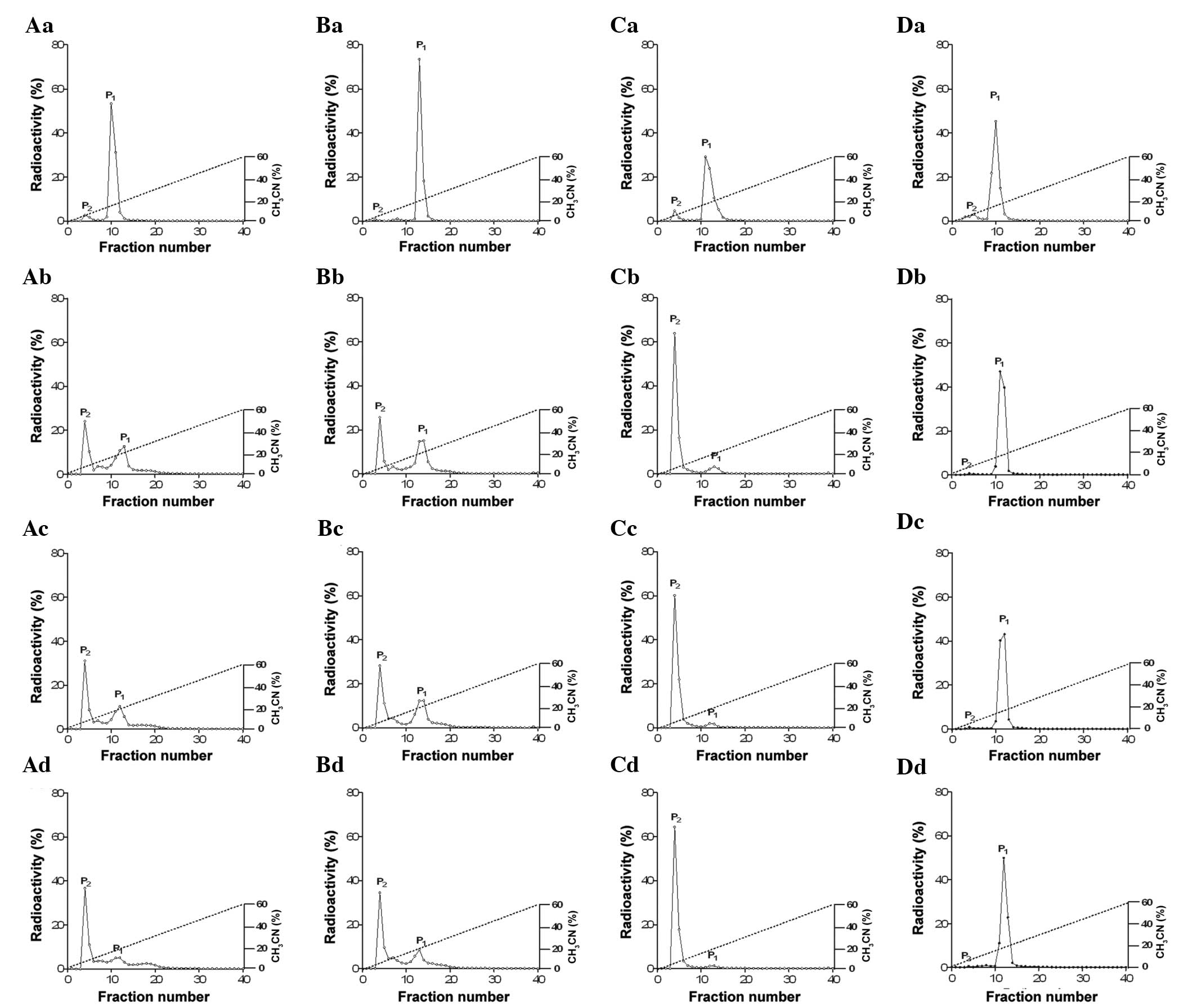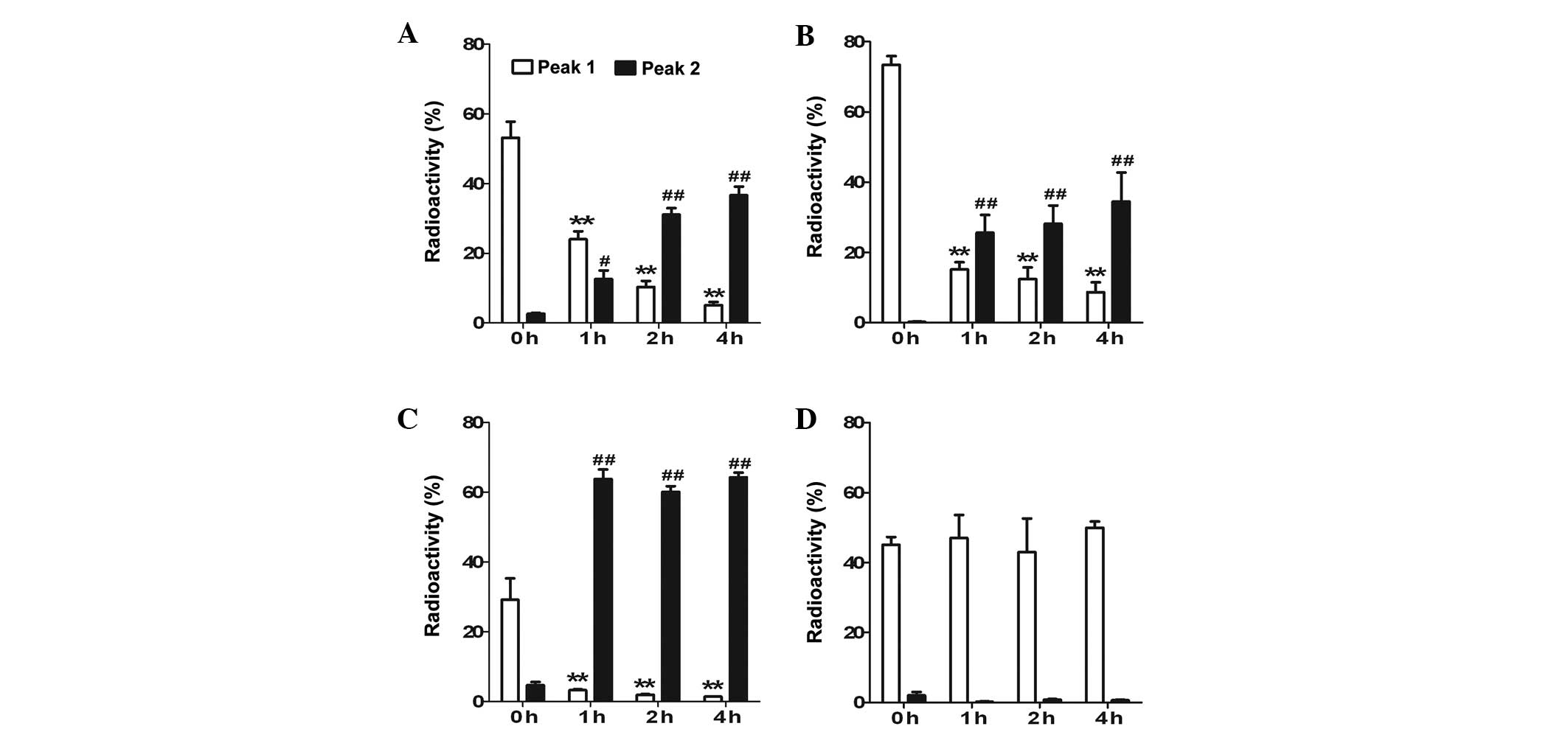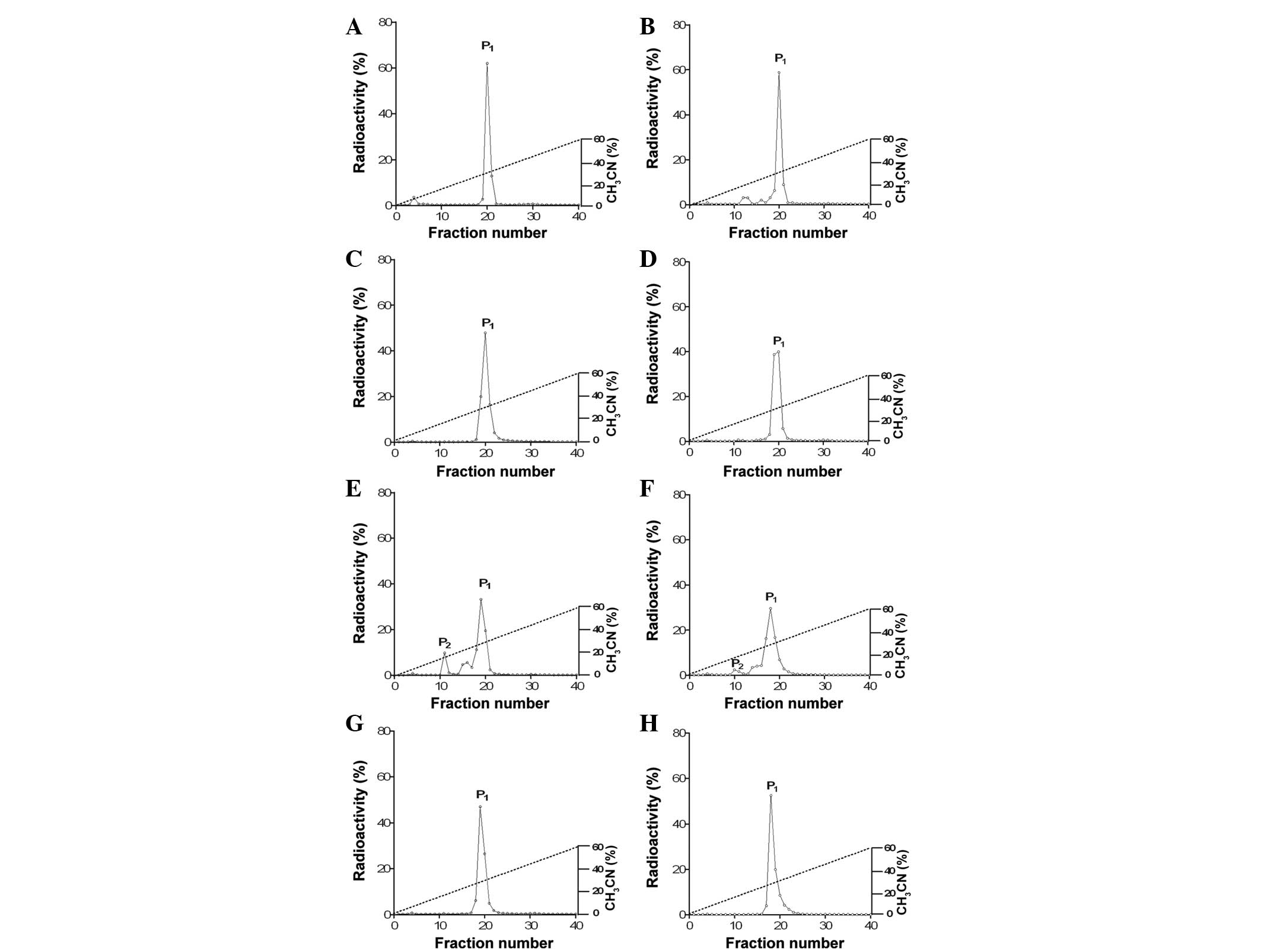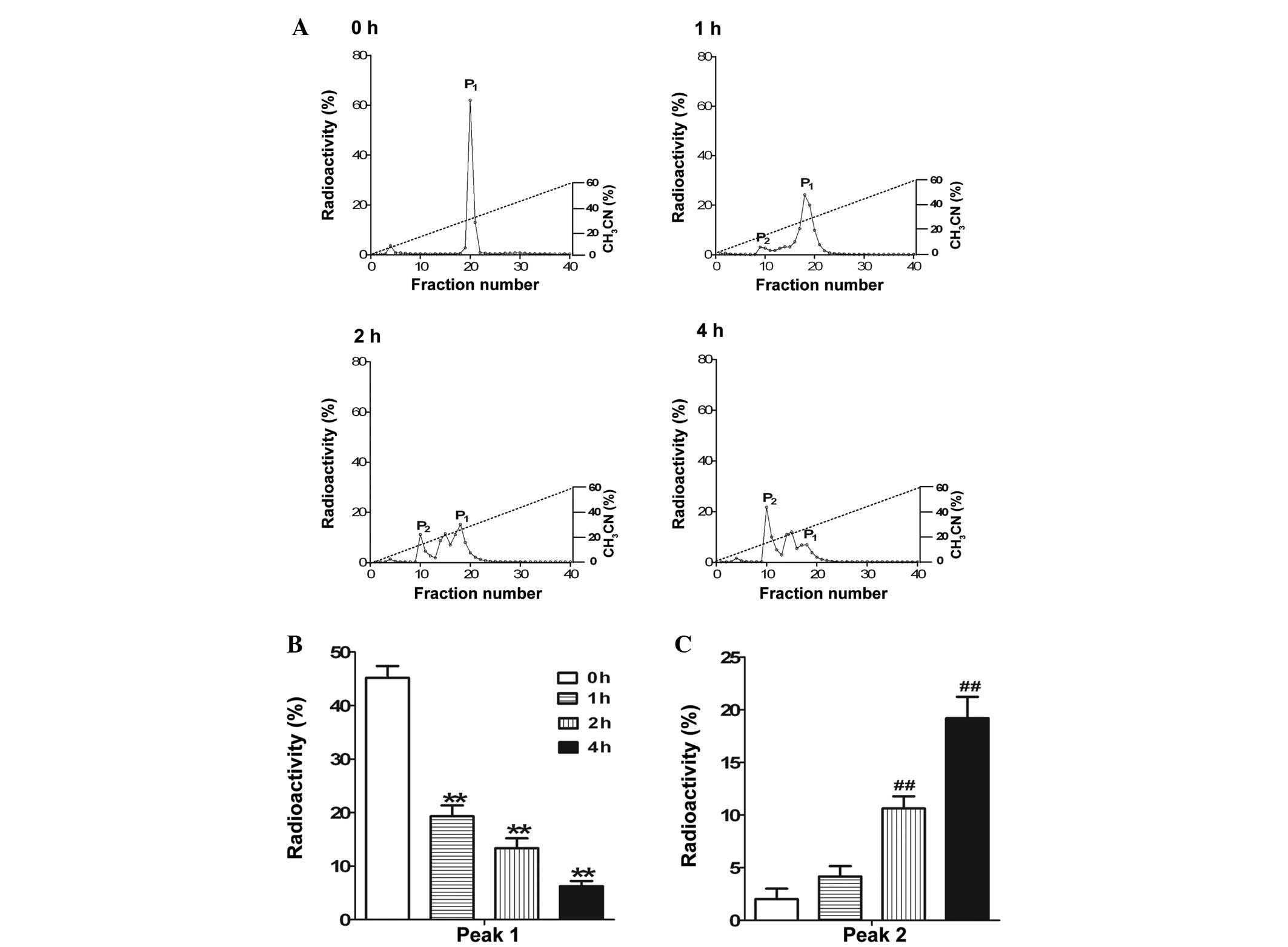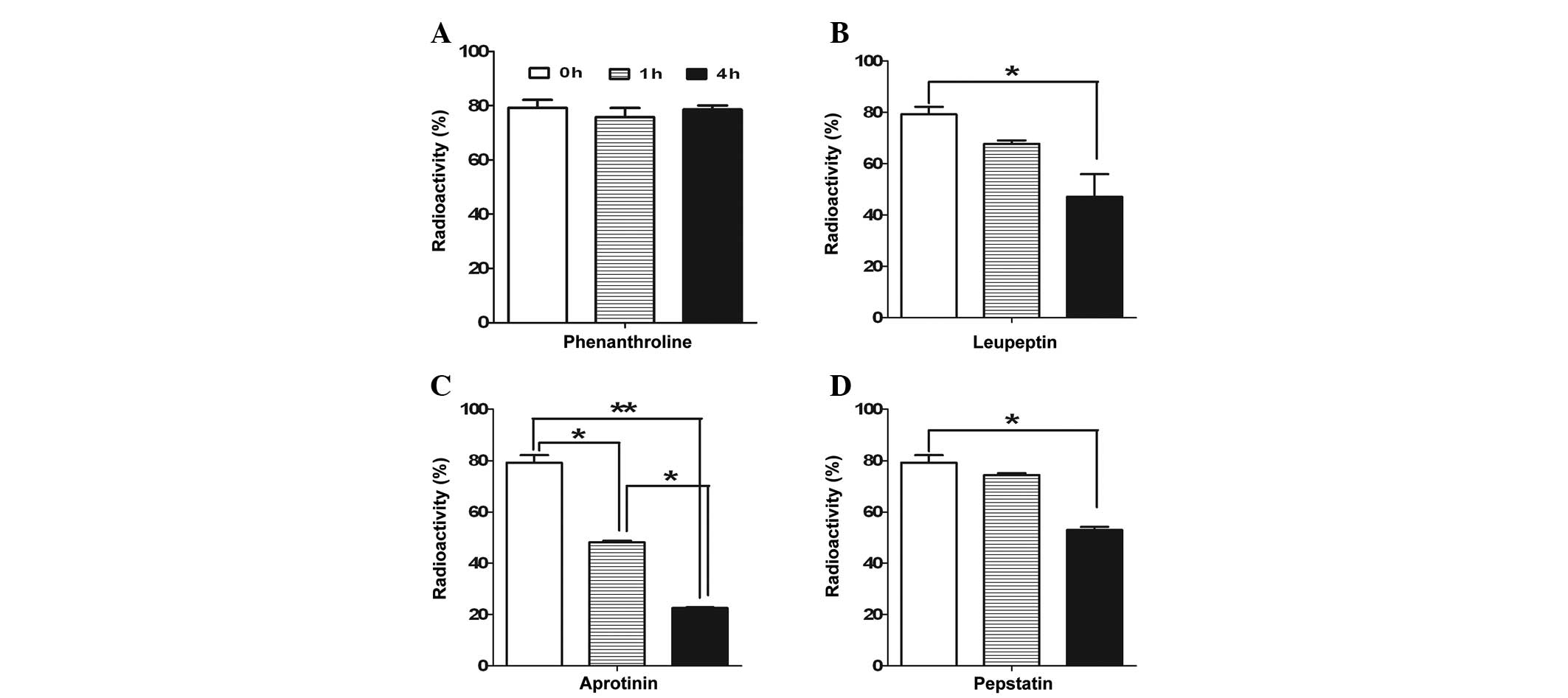Dendroaspis natriuretic peptide is degraded by a metalloproteinase in the rat kidney
- Authors:
- Published online on: December 17, 2013 https://doi.org/10.3892/mmr.2013.1871
- Pages: 1037-1043
Abstract
Introduction
Natriuretic peptides (NPs) are a family of polypeptide hormones that regulate blood pressure and fluid balance by directly affecting the kidney and the systemic vasculature. Since dendroaspis NP (DNP) has been isolated recently from the venom of snakes, the NP family now contains four members: Atrial NP (ANP), brain NP (BNP), C-type NP (CNP) and DNP (1–5). While ANP is secreted from atrial myocytes in response to an increased intravascular volume, BNP is synthesized mainly in the ventricular myocardium and is released into the blood (6). The effects of ANP are largely on the blood vessels and kidneys, where it leads to natriuresis, diuresis and a decrease in intravascular volume and blood pressure (7). The actions of BNP are similar to those of ANP, and these two peptides are hypothesized to be circulating hormones. By contrast, CNP is likely to be an autocrine or paracrine mediator, as it is only detected at extremely low levels in the plasma (8). In fact, CNP has lower hypotensive and natriuretic properties compared with ANP and BNP (9). However, contrary to our understanding of ANP, BNP and CNP, the role of DNP in mammals remains unclear.
Our recent study demonstrated that the concentration of DNP was relatively high in rabbit plasma, while the tissue contents of DNP in various organs, including the liver, spleen, intestine, atrium, ventricle, septum, kidney, cerebrum and cerebellum, were quite low (10). The major sites for DNP synthesis and secretion have not been identified, although the concentration of DNP in the plasma was markedly higher compared with that of ANP in the rabbit. Notably, the high plasma concentrations of DNP were identified to be correlated with the biological half-life of DNP in the circulation of the rabbit (10). Since the stability of DNP in plasma is a significant factor with regard to its half-life and renal functions, the current experiments were designed to confirm the stability of DNP versus ANP, BNP and CNP in rat plasma, and to determine a physiological target site for the degradation of DNP. In addition, the present study was undertaken to investigate the metabolism of DNP and to determine whether degradation of DNP stability may be mediated by specific proteinases.
Materials and methods
Plasma and tissue preparation
A total of 30 male Sprague Dawley rats (Daehan Biolink Co. Ltd., Chungbuk, South Korea) were used for the study. All the experiments conformed to the guidelines of the National Institutes of Health (Bethesda, MA, USA) and were performed with the approval of the Institutional Animal Care and Use Committee of Chonbuk National University (Jeonju, Korea). The rats were euthanized under ketamine/xylazine (90 and 10 mg/kg, respectively) anesthesia. For sampling of the plasma, the arterial blood was collected into pre-chilled tubes containing ethylenediaminetetraacetic acid (EDTA), 1 mg/ml whole blood, phenylmethylsulfonyl fluoride (0.4%) and soybean trypsin inhibitor (Nα-benzoyl-L-arginine ethyl ester, 50 U/ml). The plasma samples were obtained following centrifugation at 10,000 × g for 15 min at 4°C. The finely-diced pooled kidney, liver, spleen and lung tissues from five rats were homogenized at 4°C in 30 mM phosphate buffer (pH 7.4) and by three 30-sec bursts at 1,000 rpm (Polytron homogenizer, Fisher Scientific, Waltham, MA, USA). The homogenate was centrifuged at 1,000 × g for 10 min at 4°C and the supernatant was collected.
Iodination of ANP, BNP, CNP and DNP
125I-ANP, -BNP, -CNP and -DNP were prepared as described previously (11). Synthetic ANP, BNP, CNP and DNP (5 μg/5 μl 0.1 M acetic acid; Peninsula Laboratories, Belmont, CA, USA) were introduced into vials containing 25 μl 0.5 M phosphate-buffered saline (pH 7.4), followed by addition of 1 mCi 125I-Na (Amersham International, Buckinghamshire, UK). Chloramine-T (10 μg/10 μl) was added to the reaction vials, which were mixed gently. After 30 sec, bovine serum albumin (BSA; 60 mg/200 μl) was added. The reaction mixture was immediately applied to a Sephadex G-25 column (1.0 × 24 cm; GE Healthcare Life Science, Pittsburgh, PA, USA) and eluted with 0.1 N-acetic acid containing 0.3% BSA, 0.3% lysozyme, 0.1% glycine and 200 KIU/ml of aprotinin. Iodinated ANP, BNP, CNP and DNP were divided and stored at −70°C until further use. The iodinated ANP, BNP, CNP and DNP were purified by high-performance liquid chromatography (HPLC) on a reversed-phase Bondapak Column (Waters Associates, Milford, MA, USA) with a linear gradient (0 to 60% acetonitrile) elution immediately prior to use (12,13).
Stability of 125I-labeled ANP, BNP, CNP and DNP
The stability of the NPs was determined. In order to compare the stability of ANP to DNP, 125I-labeled ANP, BNP, CNP and DNP were incubated in rat plasma at 37°C for 1, 2 and 4 h. A reversed-phase HPLC C18 Bondapak column (4.5×2,500 mm; Waters Associates) was used for analyzing the 125I-labeled ANP and DNP. In total, ~100 μl incubated 125I-labeled peptide solution in plasma from each time-point (0, 1, 2 and 4 h after incubation) was loaded and then eluted on a linear gradient of 0–60% acetonitrile with 0.1% trifluoroacetic acid (40 min; flow rate, 1 ml/min). Degradation of the 125I-labeled ANP, BNP, CNP and DNP in the plasma was estimated by counting the radioactivity of the HPLC fractions.
Proteinase inhibitors
To investigate the main organ sites for DNP degradation, 125I-labeled DNP was incubated at 37°C for 4 h in the rat kidney, spleen, liver and lung. The quantity of protein in the tissue extracts from the spleen, lung and liver was measured and used in equal quantities (5 μg/μl). In addition, to further address the stability of DNP and determine which proteinase degrades DNP, the following proteinase inhibitors were used: The metalloproteinase, phenanthroline; the serine-cysteine proteinase, leupeptin; the serine-proteinase, aprotinin; the acid-proteinase, pepstatin; and the amino-proteinase, bacitracin.
Statistical analysis
The data are presented as the mean ± standard error of the mean. Statistical comparisons were performed using an unpaired Student’s t-test and one-way analysis of variance, followed by the multiple comparison Bonferroni t-test. P<0.05 was considered to indicate a statistically significant difference.
Results
HPLC profiles of 125I-labeled ANP, BNP, CNP and DNP during incubation in rat plasma
Radioactive values of 125I-labeled ANP, BNP, CNP and DNP were determined. 125I-labeled ANP, BNP, CNP and DNP each had one peak with a high level of radioactivity at 0 h of incubation of the rat plasma (Fig. 1, Aa, Ba, Ca and Da). Following a 1-h incubation in rat plasma, two peaks were observed with 125I-labeled ANP, BNP, CNP and DNP (Figs. 1 and 2; peak 1 is a biologically active form and peak 2 is a degraded form of the peptide). 125I-labeled ANP, BNP and CNP demonstrated a significantly increased degradation peak at 2 and 4 h following incubation in the rat plasma (Figs. 1 and 2), while 125I-labeled DNP did not reveal any differences until 4 h of incubation in the rat plasma (Figs. 1 and 2). The relative stability of the peptides in the rat plasma was DNP>>>ANP≥BNP>>CNP (Table I and Fig. 2; P<0.05). These results indicate that DNP has the most stable structure amongst the various NPs in rat plasma.
Table ISummary of bioactive degradation of 125I-labeled natriuretic peptides in plasma with a time-dependent manner.a |
Stability of 125I-labeled DNP in tissue extracts from kidney, liver, lung, heart and spleen
Since DNP was observed to be the most stable NP in plasma and may not be degraded rapidly by possible endogenous plasma proteinases, the present study sought to determine whether there is a physiological target site for the degradation of DNP in various organs. The lung, liver, spleen, kidney and heart were selected as target organs, as these organs play major roles in the metabolism of hormones. Therefore, the stability of DNP was determined by incubating 125I-labeled DNP in tissue extracts from the lung, liver, spleen, renal medulla, renal cortex, atrium and ventricle at 37°C for 1 h (Fig. 3). Following incubation, the molecular profiles of 125I-labeled DNP were analyzed. 125I-labeled DNP was significantly degraded in the tissue extracts from the renal cortex and medulla of the rats (Fig. 3E and F), indicating that the most favorable organ for the degradation of DNP may be the kidney.
Degradation rate of 125I-labeled DNP during incubation in tissue extracts from the kidney
125I-labeled DNP was incubated in tissue extracts from the renal cortex at 37°C for 1, 2 and 4 h (Fig. 4A). 125I-labeled DNP was significantly degraded in a time-dependent manner, as observed by the shifting from peak 1 towards peak 2 (Fig. 4B and C).
Effects of proteinase inhibitors on 125I-DNP stability
The mechanism by which DNP, mediated by other proteinases, is degraded in the renal cortex was investigated. Several types of proteinase inhibitors were used. As shown in Fig. 5, DNP was resistant to degradation by phenanthroline, a metalloproteinase inhibitor, regardless of time. However, leupeptin, a serine-cysteine proteinase inhibitor, significantly accelerated the degradation of 125I-labeled DNP following incubation for 4 h. Aprotinin, a serine-proteinase inhibitor, also significantly increased the degradation of 125I-labeled DNP from 1 h of incubation in tissue extracts from the kidney cortex. Finally, pepstatin, an acid-proteinase inhibitor, significantly increased the degradation of the radioactivity of 125I-labeled DNP. Therefore, these results indicate that the degradation of DNP may be mediated by a metalloproteinase.
Discussion
The aim of the present study was to further analyze the metabolic fate of DNP in rat plasma and to identify a physiological target site for the degradation of DNP in the organs. The results revealed that DNP is stable and may have a more conservative molecular structure compared with any of the other NPs against the endogenous peptidases in plasma. More significantly, the organ that metabolizes DNP may be the kidney, and degradation of DNP may be mediated by a metalloproteinase.
The present study was undertaken to compare NP stability in plasma for the first time, and the results clearly reveal evidence of the different stabilities of the NPs in rat plasma. Time-dependent degradation was identified to occur in the rank order of DNP>>>ANP≥BNP>>CNP in the incubated rat plasma. DNP was less degraded than any other peptides, while CNP was easily destroyed by theprotein enzyme. A noteworthy aspect of the present study was the observation that 125I-labeled DNP was not degraded until undergoing a 4-h incubation in plasma, while 125I-labeled CNP, BNP and ANP were significantly degraded in a time-dependent manner. These results are in agreement with earlier measurements from our laboratory (Sung Zoo Kim, Department of Physiology, Chonbuk National University, Jeonju, South Korea) demonstrating a noticeably stronger stability of DNP compared with that of ANP in rabbit plasma (14). EDTA was used to inhibit coagulation when the blood was collected. Several studies have revealed a correlation between EDTA and the stability of NPs (15,16). Tan et al (15) demonstrated that no difference was observed in ANP levels with EDTA and without EDTA in plasma sampling conditions. In addition, degradation of 125I-ANP was shown to be antagonized by EDTA (16). In the present study, a stability study of DNP was performed using no coagulator (serum), heparin or EDTA when the blood was collected. However, there were no significant differences in the DNP stabilities regardless of the use of the anticoagulators (heparin and EDTA; data not shown). Therefore, it was hypothesized that EDTA is not the main reason for the varying degradation rates between ANP, BNP, CNP and DNP.
The metabolic fate of ANP in plasma is well known (17), along with the fact that it is degraded by a neutral endopeptidase (NEP), which is a metallopeptidase (18). It has been reported that the rank order of hydrolysis by NEP in NPs is CNP>ANP>BNP, indicating that a longer length of the C-terminus of the peptide results in a greater resistance to hydrolysis by NEP (19). In the present study, CNP, which has the shortest amino acid sequence (22 amino acids), was the most rapidly degraded, while the NP with the longest amino acid sequence, DNP, was stable in the rat plasma. Therefore, the length of the C-terminus appears to be a significant factor affecting the stability of NPs. Perhaps the long half-life of DNP in plasma may be due to the strong resistance of DNP to degradation by an endopeptidase. Therefore, these results indicate that DNP may have a different metabolic fate compared with other NPs and that it may be applicable as a therapeutic agent for cardiac diseases, including congestive heart failure or hypertension. Thus, the present findings indicate that DNP is extremely stable in plasma compared with other NPs. Nevertheless, the reason for the strong stability of DNP in plasma is unknown.
Unlike the other NPs, DNP did not easily degrade in the plasma. In addition, the present study sought to determine the physiological target sites for the clearance of DNP in organs. In the present study, 125I-labeled DNP was rapidly degraded in tissue extracts from the renal cortex and medulla during incubation at 37°C for 1 h, while the tissue extracts from the spleen, lung, heart and liver were relatively stable for the same time. The kidney appears to be the major organ for the degradation of DNP. It is noteworthy that the degradation of 125I-labeled DNP in the tissue extracts from the renal cortex occurred in a time-dependent manner. ANP is degraded by the renal brush border membrane of the proximal tubule, which is extraordinarily rich in degradative enzymes (20–22). The renal brush border is not the only site of ANP degradation by NEP, although the kidney has the greatest capacity for peptide degradation (23,24). NEP is also disseminated in the thyroid, lung, brain, parts of the intestine, seminal vesicles, prostate, vascular tissue and plasma (25,26). BNP is hydrolyzed by NEP in renal microvilli (27,28). Therefore, the findings of the present study are somewhat similar to previous studies in that the kidney may be the likely organ responsible for the degradation of DNP.
The effects of proteinase inhibitors were then investigated on 125I-DNP stability in tissue extracts from rat kidneys. Phenanthroline, a metalloproteinase inhibitor, reduced the degradation of 125I-labeled DNP during incubation for 1 h in tissue extracts from the renal cortex. Furthermore, following incubation for 4 h, the degradation of 125I-labeled DNP remained attenuated by phenanthroline. The present findings are consistent with previous studies (17,18) and indicate the significance of NEP in the inactivation of DNP, similar to ANP, revealing that NEP is involved in the inactivation of BNP and ANP in the plasma. However, these observations are fairly different from an earlier study, which revealed that DNP was resistant to degradation by NEP (29). The discrepancy between the present study and previous observations revealing different degradation abilities of NEP for DNP is difficult to elucidate and further experiments are likely to be required.
In conclusion, DNP was found to have the most stable structure amongst the NPs, which may be responsible for its long half-life. Furthermore, DNP was observed to be destroyed mainly in the kidney by a metalloproteinase.
Acknowledgements
The authors would like to thank Professor Kyung Woo Cho for the valuable critique and comments. This study was supported by the Basic Science Research Program through the National Research Foundation of Korea, funded by the Ministry of Education, Science and Technology (grant nos. 2011-0014864 and 2012-0009322).
References
|
de Bold AJ: Atrial natriuretic factor: a hormone produced by the heart. Science. 230:767–770. 1985.PubMed/NCBI | |
|
de Bold AJ: Atrial natriuretic factor: an overview. Fed Proc. 45:2081–2085. 1986. | |
|
Sudoh T, Kangawa K, Minamino N and Matsuo H: A new natriuretic peptide in porcine brain. Nature. 332:78–81. 1988. View Article : Google Scholar : PubMed/NCBI | |
|
Sudoh T, Minamino N, Kangawa K and Matsuo H: C-type natriuretic peptide (CNP): a new member of natriuretic peptide family identified in porcine brain. Biochem Biophys Res Commun. 168:863–870. 1990. View Article : Google Scholar : PubMed/NCBI | |
|
Schweitz H, Vigne P, Moinier D, Frelin C and Lazdunski M: A new member of the natriuretic peptide family is present in the venom of the green mamba (Dendroaspis angusticeps). J Biol Chem. 267:13928–13932. 1992.PubMed/NCBI | |
|
Nakao K, Mukoyama M, Hosoda K, et al: Biosynthesis, secretion, and receptor selectivity of human brain natriuretic peptide. Can J Physiol Pharmacol. 69:1500–1506. 1991. View Article : Google Scholar : PubMed/NCBI | |
|
Stoupakis G and Klapholz M: Natriuretic peptides: biochemistry, physiology, and therapeutic role in heart failure. Heart Dis. 5:215–223. 2003. View Article : Google Scholar : PubMed/NCBI | |
|
Scotland RS, Ahluwalia A and Hobbs AJ: C-type natriuretic peptide in vascular physiology and disease. Pharmacol Ther. 105:85–93. 2005. View Article : Google Scholar : PubMed/NCBI | |
|
Januszewicz A: The natriuretic peptides in hypertension. Curr Opin Cardiol. 10:495–500. 1995. View Article : Google Scholar | |
|
Kim SM, Kim YA, Kim SY, Kim SH, Cho KW and Kim SZ: Presence of dendroaspis natriuretic peptide and its binding to NPR-A receptor in rabbit kidney. Regul Pept. 167:42–49. 2011. View Article : Google Scholar : PubMed/NCBI | |
|
Cho KW, Kim SH, Kim CH and Seul KH: Mechanical basis of ANP secretion in beating atria: atrial stroke volume and ECF translocation. Am J Physiol. 268:R1129–R1136. 1995.PubMed/NCBI | |
|
Morris BJ: Specific radioactivity of radioimmunoassay tracer determined by self-displacement: a re-evaluation. Clin Chim Acta. 73:213–216. 1976. View Article : Google Scholar : PubMed/NCBI | |
|
Joseph LJ, Desai KB, Mehta MN and Mathiyarasu R: Measurement of specific activity of radiolabelled antigens by a simple radioimmunoassay technique. Int J Rad Appl Instrum B. 15:589–590. 1988. View Article : Google Scholar : PubMed/NCBI | |
|
Kim SM, Kim SY, Kim SH, Cho KW and Kim SZ: Renal actions of dendroaspis natriuretic peptide in rabbits. Peptides. 33:59–66. 2012. View Article : Google Scholar : PubMed/NCBI | |
|
Tan AC, Rosmalen FM, Theelen BG, Kloppenborg PW, Benraad HB and Benraad TJ: Atrial natriuretic peptide - the influence of various physiological and sampling conditions. Ann Clin Biochem. 24:500–507. 1987. View Article : Google Scholar : PubMed/NCBI | |
|
Rugg EL, Aiton JF and Cramb G: Degradation of [125I]-atrial natriuretic peptide by a soluble metallopeptidase isolated from rat ventricular myocytes. Biochem Biophys Res Commun. 152:294–300. 1988. | |
|
Olins GM, Spear KL, Siegel NR, Reinhard EJ and Zurcher-Neely HA: Atrial peptide inactivation by rabbit-kidney brush-border membranes. Eur J Biochem. 170:431–434. 1987. View Article : Google Scholar : PubMed/NCBI | |
|
Lisy O, Jougasaki M, Schirger JA, Chen HH, Barclay PT and Burnett JC Jr: Neutral endopeptidase inhibition potentiates the natriuretic actions of adrenomedullin. Am J Physiol. 275:F410–F414. 1998.PubMed/NCBI | |
|
Dussaule JC: Natriuretic factors of cardiac origin: renal effects. Rev Prat. 43(20 Suppl): 13–17. 1993.(In French). | |
|
Stephenson SL and Kenny AJ: The hydrolysis of alpha-human atrial natriuretic peptide by pig kidney microvillar membranes is initiated by endopeptidase-24.11. Biochem J. 243:183–187. 1987.PubMed/NCBI | |
|
Stephenson SL and Kenny AJ: The metabolism of neuropeptides. Hydrolysis of peptides by the phosphoramidon-insensitive rat kidney enzyme ‘endopeptidase-2’ and by rat microvillar membranes. Biochem J. 255:45–51. 1988.PubMed/NCBI | |
|
Johnson GR, Arik L and Foster CJ: Metabolism of 125I-atrial natriuretic factor by vascular smooth muscle cells. Evidence for a peptidase that specifically removes the COOH-terminal tripeptide. J Biol Chem. 264:11637–11642. 1989. | |
|
Erdös EG and Skidgel RA: Neutral endopeptidase 24.11 (enkephalinase) and related regulators of peptide hormones. FASEB J. 3:145–151. 1989. | |
|
Erdös EG, Wagner B, Harbury CB, Painter RG, Skidgel RA and Fa XG: Down-regulation and inactivation of neutral endopeptidase 24.11 (enkephalinase) in human neutrophils. J Biol Chem. 264:14519–14523. 1989. | |
|
Yandle TG, Brennan SO, Espiner EA, Nicholls MG and Richards AM: Endopeptidase-24.11 in human plasma degrades atrial natriuretic factor (ANF) to ANF(99-105/106-126). Peptides. 10:891–894. 1989. View Article : Google Scholar : PubMed/NCBI | |
|
Tamburini PP, Koehn JA, Gilligan JP, et al: Rat vascular tissue contains a neutral endopeptidase capable of degrading atrial natriuretic peptide. J Pharmacol Exp Ther. 251:956–961. 1989.PubMed/NCBI | |
|
Bourne A and Kenny AJ: The hydrolysis of brain and atrial natriuretic peptides by porcine choroid plexus is attributable to endopeptidase-24.11. Biochem J. 271:381–385. 1990.PubMed/NCBI | |
|
Vanneste Y, Pauwels S, Lambotte L and Deschodt-Lanckman M: In vivo metabolism of brain natriuretic peptide in the rat involves endopeptidase 24.11 and angiotensin converting enzyme. Biochem Biophys Res Commun. 173:265–271. 1990. View Article : Google Scholar : PubMed/NCBI | |
|
Chen HH, Lainchbury JG and Burnett JC Jr: Natriuretic peptide receptors and neutral endopeptidase in mediating the renal actions of a new therapeutic synthetic natriuretic peptide dendroaspis natriuretic peptide. J Am Coll Cardiol. 40:1186–1191. 2002. View Article : Google Scholar |



